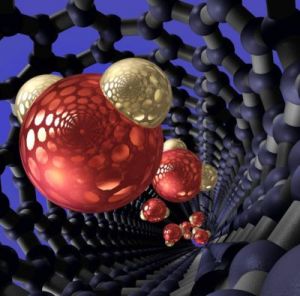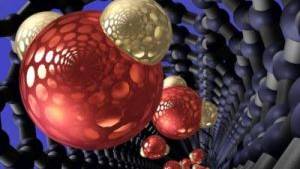Nanofilters could stall looming water crisis
Source: cosmosmagazine.com
 Carbon nanotubes may revolutionise the process of converting salt water to fresh water and provide an energy-saving solution to the increasing global demand for fresh drinking water, researchers say.
Carbon nanotubes may revolutionise the process of converting salt water to fresh water and provide an energy-saving solution to the increasing global demand for fresh drinking water, researchers say.In a new report, computer modelling was used to study how fluid flows at the molecular level. One of their aims was to find the optimum design for a carbon nanotube (CNT) membrane that can be used in the desalination process.
Thee simulations suggest that this membrane may be 20 to 5,000 times more permeable to water than current commercial scale reverse osmosis membranes, depending on tube density.
“If a new material is found that can maximise water transport through the separating membrane, while at the same time rejecting dissolved ions and other particulates in seawater, reverse osmosis would be a much more efficient process,” said lead author Jason Reese, professor of thermodynamics and fluid mechanics at the University of Strathclyde, Glasgow, Scotland.
Demand for drinking water on the increase
With the global population predicted to reach 9.5 billion by the latter half of this century, the demand for drinking water is only going to increase. Already, more than a billion people are faced with insufficient fresh water resources.
This week, 20 former heads of state, including former U.S. president Bill Clinton and former Japanese prime minister Yasuo Fukuda, warned of an impending "water crisis", and will establish a panel to tackle a worldwide leadership gap on the issue.
Trends in climate change have been shown to predict a redistribution of rainfall globally, with dry regions of the planet only getting dryer.
Huge costs of desalination
Most desalination plants convert salt water to fresh water using reverse osmosis. Pressure is applied to the salt water solution forcing the water through a permeable membrane that separates the pure water from the salts.
There are huge costs associated with desalination plants, however, as they require expensive infrastructure and large amounts of energy. With current technology, it is five times more expensive to desalinate water than to extract groundwater, but CNTs may change this.
Carbon nanotubes are sheets of graphene – one-atom thick carbon – rolled into cylinders. Their versatility lies in the fact that they can be a nanometre in diameter, with a tube length many millions of times longer. They are highly efficient at repelling salt ions. In solution, salts are surrounded by hydrating water molecules, which must be shed in order to pass through the CNTs.
This process takes a lot of energy and as a result doesn’t happen very often. Therefore, the right sized nanotube will optimise water transport while minimising salt ion permeability.
Read the full article at: cosmosmagazine.com
Video from: YouTube.com
Video from: YouTube.com






















